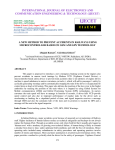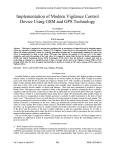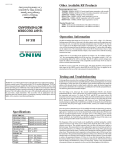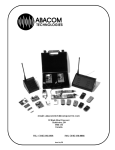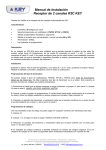Download accident avoidance and track failure identification syytem in south
Transcript
Global Journal of Advanced Engineering Technologies, Vol3, Issue3-2014 ISSN: 2277-6370 ACCIDENT AVOIDANCE AND TRACK FAILURE IDENTIFICATION SYYTEM IN SOUTH CENTRAL RAILWAYS 1,2,3 M. Naga Sai Nikhil1, M.Venkata Krishnakanth2, S.Venkata Naga Siva3, B.Tech student , V.R.Siddhartha Engineering college, Andhra Pradesh,India. Abstract: - Track failure identification system is an advanced method used to identify the track failure and send the signal is transmitted to alert the train driver who is passing through that way in this project the track failure can be identified by using IR sensors and send the signals to the driver by using RF Communication. RF communication is very efficient communication for sending the signals immediately. Radio frequency (RF) is widely used technology in wireless communications .the RF module is an Electronic circuit it involves two sub units named transmitter and receiver to provide the wireless communication. Train accidents have been increased rapidly due to the track failures because the detection of track failure is taking time and also sending a message about the track failure to the driver and appropriate action to be taken by drivers becomes delayed. This project is aimed to detect the track failure conditions using IR and sending the signals to the driver if any track is failed the RF transmitter sends the signal to the receiver. In train section the alarm will be on, and also display the track failure information by using LCD. . I. INTRODUCTION Security is the condition of being protected against danger or loss. In the general sense, security is a concept similar to safety. The nuance between the two is an added emphasis on being protected from dangers that originate from outside. Individuals or actions that encroach upon the condition of protection are responsible for the breach of security. The word "security" in general usage is synonymous with "safety," but as a technical term "security" means that something not only is secure but that it has been secured. One of the best options for providing good security is by using a technology named EMBEDDED SYSTEMS. An Embedded system can be defined as a computing device that does a specific focused job. Appliances such as the air-conditioner, VCD player, DVD player, printer, fax machine, mobile phone etc. are examples of embedded systems. Each of these appliances will have a processor and special hardware to meet the specific requirement of the application along with the embedded software that is executed by the processor for meeting that specific requirement. The embedded software is also called “firm ware”. The desktop/laptop computer is a general purpose computer. You can use it for a variety of applications such as playing games, word processing, accounting, software development and so on. In contrast, the software in the embedded systems is always fixed listed below, Embedded systems do a very specific task; they cannot be programmed to do different things. Embedded systems have very limited resources, particularly the memory. Generally, they do not have secondary storage devices such as the CDROM or the floppy disk. Embedded systems have to work against some deadlines. A specific job has to be completed within a specific time. In some embedded systems, called real-time systems, the deadlines are stringent. Missing a deadline may cause a catastrophe-loss of life or damage to property. Embedded systems are constrained for power. As many embedded systems operate through a battery, the power consumption has to be very low. The rest of the paper is as follow. In Section 2, we explain the proposed setup of the system i.e., the block diagram and its description. Section 3 explains the working of the proposed system. We conclude the paper in Section 4 describing our accomplishments. II. PROPOSED METHOD The block diagram consists of different components interfacing to a microcontroller. The block diagram is shown in Figure1. 288 Global Journal of Advanced Engineering Technologies, Vol3, Issue3-2014 Transmitter section: ISSN: 2277-6370 standard 80C51 and 80C52 instruction set and pin out. The on-chip Flash allows the program memory to be reprogrammed in-system or by a conventional nonvolatile memory programmer. By combining a versatile 8-bit CPU with in-system programmable Flash one monolithic chip, the Atmel AT89S52 is a powerful micro- controller which provides a highly-flexible and cost-effective solution to many embedded control applications. Features of the microcontroller: Figure 1: Block Diagram Receiver section: · It is a 8-bit microcontroller. · 8K Bytes of In-System Programmable (ISP) Flash Memory. · -Endurance: 1000 Write/Erase Cycles · Fully Static Operation: 0 Hz to 33 MHz · 256 x 8-bit Internal RAM. · 32 Programmable I/O Lines. · Three 16-bit Timer/Counters. · Eight Interrupt Sources. · Full Duplex UART Serial Channel. B) Power Supply: The various components in the block diagram are mentioned below: 1. 2. 3. 4. 5. 6. 7. 8. 9. 10. 11. AT89S52 Microcontroller Power Supply Crystal Oscillator Reset 16x2 Liquid Crystal Display(LCD) RF receiver Decoder RF Transmitter Buzzer Decoder IR sensor A) Microcontroller Unit The AT89S52 is a low-power, high performance CMOS 8- bit microcontroller with 8K bytes of insystem programmable Flash memory. The device is manufactured using Atmel’s high-density nonvolatile memory technology and is compatible with the industry The input to the circuit is applied from the regulated power supply. The microcontroller voltage is of 5V. The A.C. input i.e., 230V from the mains supply is step down by the transformer to 12V and is fed to a rectifier. The output obtained from the rectifier is a pulsating D.C voltage. So in order to get a pure D.C voltage, the output voltage from the rectifier is fed to a filter to remove any A.C components present even after rectification. Now, this voltage is given to a voltage regulator to obtain a pure constant dc voltage. We are using an IC 7805 as voltage regulator to get a 5V output Voltage. C) Crystal Oscillator A crystal oscillator is an electronic oscillator circuit that uses the mechanical resonance of a vibrating crystal of piezoelectric material to create an electrical signal with a very precise frequency. This frequency is commonly used to keep track of time (as in quartz wrist watches), to provide a stable clock signal for digital integrated circuits, and to stabilize frequencies for radio transmitters and receivers. The most common type of piezoelectric resonator used is the quartz crystal, so oscillator circuits designed around them became known as “crystal oscillators”. This block provides necessary frequency sine wave to the micro controller. This frequency is converted to square wave within the micro controller. D) Reset Control reset is to execute the entire program cycle from beginning. 289 Global Journal of Advanced Engineering Technologies, Vol3, Issue3-2014 E) Liquid Crystal Display (LCD) LCD (Liquid Crystal Display) screen is an electronic display module and find a wide range of applications. A 16x2 LCD means it can display 16 characters per line and there are 2 such lines. In this JHD 16x2A LCD each character is displayed in 5x7 pixel matrix. The schematic diagram of 16x2 LCD is shown in Fig.2. This LCD has two registers, namely, Command and Data. The command register stores the command instructions given to the LCD. A command is an instruction given to LCD to do a predefined task like initializing it, clearing its screen, setting the cursor position, controlling display etc. The data register stores the data to be displayed on the LCD. The data is the ASCII value of the character to be displayed on the LCD. Some of the LCD command codes are listed in Table 1. Features: · · · · · · · · · · Interface with either 4-bit or 8-bit microprocessor. Display data RAM. 80x8 bits (80 characters). Character generator ROM and RAM. 160 different 5x7 dot-matrix character patterns. 8 different users programmed 5x7 dotmatrix patterns. Numerous instructions. Clear Display, Cursor Home, Display ON/OFF, Cursor. ON/OFF, Blink Character, Cursor Shift, Display Shift. Built-in reset circuit is triggered at power ON. ISSN: 2277-6370 Table 1: LCD Command Codes Code(Hex) 01 06 Command to LCD Instruction Register Clear display of the screen Automatic increment 38 2 line 5x7 Matrix 0F Display is on and the cursor blinks 80 Force Cursor to begin from 1’st line C0 Force Cursor to begin from 2nd line The LCD display is connected to the output port of micro controller to display the cyclic operations of vigilance control device. F) Buzzer A buzzer or beeper is a signaling device, usually electronic, typically used in automobiles, household appliances such as a microwave oven, or game shows. It most commonly consists of a number of switches or sensors connected to a control unit that determines if and which button was pushed or a preset time has lapsed, and usually illuminates a light on the appropriate button or control panel, and sounds a warning in the form of a continuous or intermittent buzzing or beeping sound. Initially this device was based on an electromechanical system which was identical to an electric bell without the metal gong (which makes the ringing noise). Often these units were anchored to a wall or ceiling and used the ceiling or wall as a sounding board. Another implementation with some ACconnected devices was to implement a circuit to make the AC current into a noise loud enough to drive a loudspeaker and hook this circuit up to a cheap 8-ohm speaker. Now-adays, it is more popular to use a ceramic-based piezoelectric sounder like a Sonalert which makes a high-pitched tone. Usually these were hooked up to driver” circuits which varied the pitch of the sound or pulsed the sound on and off. Buzzer Driver: VCC 12 V + Buz - Figure 2: Schematic diagram of 16×2 LCD µC PORT D? 4007 Q? BC547 290 Global Journal of Advanced Engineering Technologies, Vol3, Issue3-2014 The circuit is designed to control the buzzer. The buzzer ON and OFF is controlled by the pair of switching transistors (BC 547). is conducting and close the collector and emitter terminal so zero signals is given to base of the Q2 transistor. Hence Q2 transistor and buzzer is turned OFF state. When low pulse is given to base of transistor Q1, the transistor is turned OFF. Now 12V is given to base of Q2 transistor so the transistor is conducting and buzzer is energized and produces the sound signal. G) HT12E ENCODER: General Description: The 212 encoders are a series of CMOS LSIs for remote control system applications. They are capable of encoding information which consists of N address bits and 12_N data bits. Each address/data input can be set to one of the two logic states. The programmed addresses/ data are transmitted together with the header bits via an RF or an infrared transmission medium upon receipt of a trigger signal. The capability to select a TE trigger on the HT12E or a DATA trigger on the HT12A further enhances the application flexibility of the 212 series of encoders. The HT12A additionally provides a 38 kHz carrier for infrared systems. Features: · · · · · · · · · · · · Operating voltage 2.4V~5V for the HT12A 2.4V~12V for the HT12E Low power and high noise immunity CMOS technology Low standby current: 0.1_A (typ.) at VDD=5V HT12A with a 38kHz carrier for infrared transmission medium Minimum transmission word Four words for the HT12E One word for the HT12A Built-in oscillator needs only 5% resistor Data code has positive polarity Minimal external components Pair with Holtek_s 212 series of decoders 18-pin DIP, 20-pin SOP package Applications · · · · · · · · ISSN: 2277-6370 Garage door controllers Car door controllers Car alarm system Security system Cordless telephones Other remote control systems H) HT12D DECODER: The 212 decoders are a series of CMOS LSIs for remote control system applications. They are paired with Holtek_s 212 series of encoders (refer to the encoder/decoder cross reference table). For proper operation, a pair of encoder/decoder with the same number of addresses and data format should be chosen. The decoders receive serial addresses and data from a programmed 212 series of encoders that are transmitted by a carrier using an RF or an IR transmission medium. They compare the serial input data three times continuously with their local addresses. If no error or unmatched codes are found, the input data codes are decoded and then transferred to the output pins. The VT pin also goes high to indicate a valid transmission. The 212 series of decoders are capable of decoding information’s that consist of N bits of address and 12_N bits of data. Of this series, the HT12D is arranged to provide 8 address bits and 4 data bits, and HT12F is used to decode 12 bits of address information. Features · · · · · · · · · · · · · · Operating voltage: 2.4V~12V Low power and high noise immunity CMOS technology Low standby current Capable of decoding 12 bits of information Binary address setting Received codes are checked 3 times Address/Data number combination HT12D: 8 address bits and 4 data bits HT12F: 12 address bits only Built-in oscillator needs only 5% resistor Valid transmission indicator Easy interface with an RF or an infrared transmission medium Minimal external components Pair with Holtek_s 212 series of encoders 18-pin DIP, 20-pin SOP package Burglar alarm system Smoke and fire alarm system 291 Global Journal of Advanced Engineering Technologies, Vol3, Issue3-2014 Functional Description: Operation The 212 series of decoders provides various combinations of addresses and data pins in different packages so as to pair with the 212 series of encoders. The decoders receive data that are transmitted by an encoder and interpret the first N bits of code period as addresses and the last 12_N bits as data, where N is the address code number. A signal on the DIN pin activates the oscillator which in turn decodes the incoming address and data. The decoders will then check the received address three times continuously. If the received address codes all match the contents of the decoder local address, the 12_N bits of data are decoded to activate the output pins and the VT pin is set high to indicate a valid transmission. This will last unless the address code is incorrect or no signal is received. The output of the VT pin is high only when the transmission is valid. Otherwise it is always low. Applications · · · · · · · · Burglar alarm system Smoke and fire alarm system Garage door controllers Car door controllers Car alarm system Security system Cordless telephones Other remote control systems III. SIMULATION AND MODELING Traditionally circuit simulation has been a non interactive affair. In the early days net list were prepared by hand, and output considered of reams of numbers. Proteus Simulation Software: Proteus Virtual System Modeling (VSM) combines mixed mode SPICE circuit simulation, animated components and microprocessor models to facilitate co simulation of complete micro-controller based designs. For the first time ever, it is possible to develop and test such designs before a physical prototype is constructed. This is possible because one can interact with the design using on screen indicators such as LED and LCD displays and actuators such as switches and buttons. The simulation takes place in real time (or near enough to it): a 300 MHz Pentium II can simulate a basic 8051 system clocking at over 12MHz. Proteus VSM also provides extensive debugging facilities ISSN: 2277-6370 including breakpoints, single stepping and variable display for both assembly code and high level language source. IV. CONCLUSION In this paper, an automatically Track failure identification system is designed and simulated. The simulation has been done using proteus and testing has been carried out using the developed prototype. This method of track failure Identification system is enormous and very applicable. It is even advantageous to avoid the train accidents in south central railways and efficient way to find out the track failure conditions. REFERENCES [1] ITSR, Driver Safety Systems Discussion Paper, 2006, Australia/New South Wales Independent Transport Safety Regulator: Sydney, p.32. [2] Whitlock, Driver vigilance devices: systems review (and RSSB response) 2002, Rail Safety and Standards Board/Quintec, p.105. [3] Santosh B. Patil, Rupal M. Walli, “Design and Develop- ment of Fully Automatic AT89C52 Based Low Cost Embedded System For Rail Tracking”, International Journals of Electronics, Communication and Soft Computing Science and Engineering (IJECSCSE), Vol.1, Issue 1,Pg 9-14. [4] M. A. Mazidi, “The 8051 Microcontroller & Embedded Systems”, Pearson Education Asia, nd India, 2 edition, 2008. [5] Raj Kamal, “Embedded System- Architecture, Program- ming and Design”, Tata McGraw Hill nd [6] [7] [8] [9] Publisher, 2 edition, 2008. GSM User Manual, SIMCOM LTD, August 2006. http://www.atmel.com http://www.simcom.com Sky Traq Venus 6 GPS Module ST22 Data Sheet. 292






